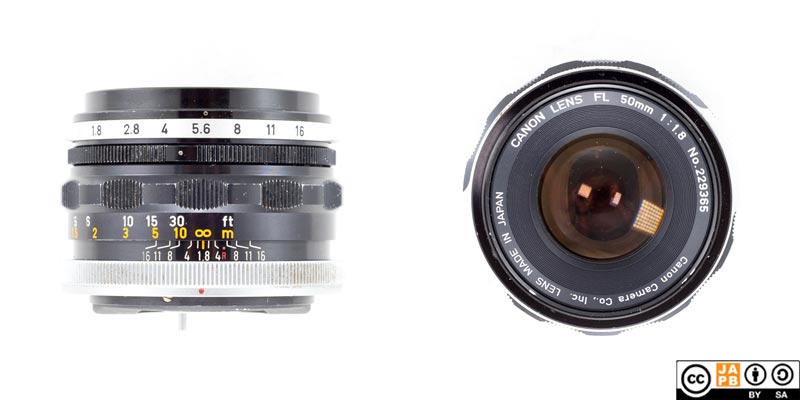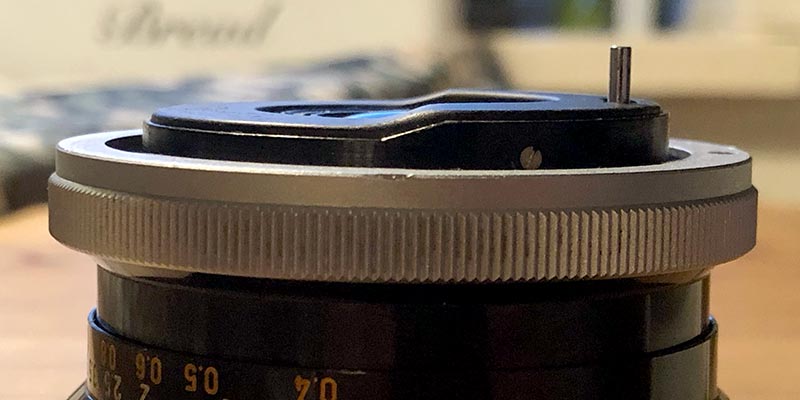Pekka Buttler, 09/2023

Specifications
The table below summarizes the lens’ key specifications:
| Brand: | Canon | Lens name | FL 50mm 1:1.8 |
| Focal length(s) 1 | 50 mm | Angle-of-view 2 | 46° |
| Maximum Aperture | f/1.8 | In Production | 1964–1971 (all versions) |
| Lens mount | Canon FL | Subfamily (if applicable) | N/A |
| Length 3 | 42,3 mm | Diameter 4 | 61,0 mm (locking ring) 60,2 mm (lens housing) |
| Filter ring diameter | 48 mm | Weight | 229 grams |
| Lens element count | 6 | Lens group count | 4 |
| Aperture blades (S/R/C) 5 | 6 S | Focus throw | 195 ° |
| Minimum focusing distance | 60 cms | Maximum magnification | 1:9,9 |
| Has manual aperture ring | YES | Has Manual focus ring | YES |
| Aperture mechanism type | Automatic | Aperture click stops 6 | 1.8-2.8-4-5.6-8-11-16 |
Further notes:
• There were two variants of the Canon FL 50 mm f/1.8 lens. The first (1964–68) had the typical dual ring aperture control arrangement while the later version (1968–1971) sports the A/M control ring between locking ring and focus ring. The pictured sample is of the earlier type
• This lens’ filter ring sports the (today) somewhat nonstandard diameter of 48 mm. The typical lens cap was a slip-on lens cap with the inner diameter of 50 mm.
• Canon FL lenses used slip-on (with tightening screw) lens hoods. The intended lens hood is the Canon S-50 lens hood. Shorter variants (W-50) can equally be used but offer less protection against oblique rays. The longer variant (T-50) may produce some hard vignetting.
History of Canon FL lenses
Canon is undoubtedly one of the great names in 35 mm SLR photography. Ever since the 1959 introduction of the Canonflex – Canon’s first interchangeable lens SLR – Canon has constantly focused on being at the forefront of Camera innovation. Often this has necessitated taking stock and redesigning both cameras, lenses and lens mounts. Unlike its archival Nikon, Canon has not tried to integrate all novel features in the same lens mount, but has instead repeatedly launched new, modified mounts to facilitate new features, while still often (but not always) managing to maintain a decent degree of backwards compatibility.
In short (a longer version is here), the development of Canon SLR mounts can be traced as follows:
• 1959–1963: R-mount 7. Canon’s first SLR lens mount. Breech lock-type mount with aperture automation (camera is able to stop down lens for taking the shot.
• 1964–1969: FL-mount. Breech-lock type mount, physically similar mount as Canon R-mount, but camera-to-lens communication linkages somewhat different. Cannot communicate selected aperture to body (stop-down-metering only).
• 1970–1978: FD-mount. Breech-lock mount. FD lenses compatible with FL-cameras and vice versa. Manual focus lenses that communicate aperture information to camera, hence opening the door for automatic exposure (both shutter priority and aperture priority possible)
• 1979–1986: new FD-mount (a.k.a. FDn). Bayonet mount, backwards compatible with FL and FD mounts. Otherwise, as FD mount.
• 1987–today: EF-mount. Electronically controlled autofocus lenses that use an internal focusing motor. Compatible with previous mount lenses only using an adapter with optics.
While many see the Canon FL mount lenses as risky oddities compared to the subsequent FD and FDn lenses, Canon’s lineup of FL lenses is not to be frowned at as, in many ways, the FL lenses laid the groundwork for the subsequent success of the FD system. Granted, the coating technology is decidedly dated, and the need for stop-down metering is decidedly a hassle on Canon FD bodies, but especially when adapting lenses on mirrorless cameras, Canon FL lenses offer an interesting value proposition
Related versions
Canon has a long history of manufacturing f/1.8 50 mm lenses, that can be summarised (based on data from the Canon camera museum) as:
• R 50 mm f/1.8 (I) (1959–1960), 6 elements in 4 groups, 58 mm filter, ? blades, 295 grams
• R 50 mm f/1.8 (II) (1960–1963), 6 elements in 4 groups, 58 mm filter, ? blades, 305 grams
• R 50 mm f/1.8 (III) (1963–1964), 6 elements in 4 groups, 58 mm filter, ? blades, 295 grams [data sheet]
• FL 50 mm f/1.8 (I) (1964–1968), 6 elements in 4 groups, 48 mm filter, 6 blades, 228 grams [data sheet]
• FL 50 mm f/1.8 (II) (1968–1971), 6 elements in 4 groups, 48 mm filter, 6 blades, 280 grams
• FD 50 mm f/1.8 chrome nose (I) (1971–1971), 6 elements in 4 groups, 55 mm filter, 6 blades, 305 grams
• FD 50 mm f/1.8 chrome nose (II) (1971–1973), 6 elements in 4 groups, 55 mm filter, 6 blades, 305 grams [data sheet]
• FD 50 mm f/1.8 S.C. (I) (1973–1976), 6 elements in 4 groups, 55 mm filter, 6 blades, 255 grams
• FD 50 mm f/1.8 S.C. (II) (1976–1979), 6 elements in 4 groups, 55 mm filter, 5 blades, 200 grams
• FDn 50 mm f/1.8 (1979–1987), 6 elements in 4 groups, 52 mm filter, 5 blades, 170 grams [data sheet]
• EF 50 mm f/1.8 (I) (1987–1990), 6 elements in 5 groups, 52 mm filter, 5 blades, 190 grams [data sheet]
• EF 50 mm f/1.8 (II) (1990-today), 6 elements in 5 groups, 52 mm filter, 5 blades, 130 grams
• RF 50 mm f/1.8 STM (2020-today), 6 elements in 5 groups, 43 mm filter, 7 blades, 160 grams
Adapting
NOTE! Unless noted otherwise, the following applies to all Canon FL lenses:
This lens cannot be used natively on any current SLR or dSLRs. To use it in its native environment, you will need a Canon FL or FD-mount film body.
Thanks to being a fully manual lens (manual aperture, manual focus), the lens can be adapted to all mirrorless cameras using a suitable adapter. However, to be able to stop down the lens, you will need to take one of two routes:
1) Acquire a Canon FD adapter and use its ability to engage the FD/FL lens’ aperture control lever, to make sure that the diaphragm’s opening always reflects the aperture ring’s selection.
2) Acquire a Canon FL adapter (or modify a Canon FD adapter by removing its aperture control lever) and instead engage the FL lens’ preset ring before taking a shot.
Moreover, a large range of special adapters (helicoid adapters, tilt/shift adapters, speed boosters) for using Canon FD (And, hence, Canon FL) lenses on most mirrorless systems are available.
Using Canon FL lenses on dSLRs is a possibility, but is not problem free. Thanks to the relatively short flange focal distance of the Canon FL/FD mount (at 42,0 mm, clearly shorter than that of any full-frame dSLR mount), any adapter will necessitate some optics to achieve infinity focus. Again, a Canon FD adapter should work…
Special note on adapting the FL 50/1,8:
This lens (along with some other canon FL lenses) has the bulge – a quirk that may make you unable to mount it on your Canon FD-to-whatever adapter: The rear part of its aperture activation mechanism protrudes so far back, that it might interfere with your adapter (see image below), making it impossible to mount the lens securely. I personally have five different CanonFD-mirrorless adapters, all but one of which has this problem, and even while it allows the lens to be mounted, the aperture control lever may abrade the paint on the lens.

Footnotes
- Focal length is (unless stated otherwise) given in absolute terms, and not in Full-frame equivalent. For an understanding of whether the lens is wide/tele, see ‘Angle-of-view’. ↩︎
- Picture angle is given in degrees (based on manufacturers’ specs) and concerns the diagonal picture angle. Rule of thumb:
> 90 ° ==> Ultra-wide-angle
70–90 ° ==> Wide-angle
50–70 ° ==> Moderate wide-angle
40–50 ° ==> ‘Standard’ or ‘normal’ lens
20–40 ° ==> Short tele lens
10-20 ° ==> Tele lens
5-10 ° ==> Long tele lens
< 5 ° ==> Ultra-tele lens ↩︎ - Length is given from the mount flange to the front of lens at infinity. ↩︎
- Diameter excludes protrusions such as rabbit ears or stop-down levers. ↩︎
- S=straight; R=rounded; C=(almost)circular at all apertures. ↩︎
- Numbers equal aperture values on aperture ring; • intermediate click; – no intermediate click. ↩︎
- The Canon-R mount should possibly be renamed to (or referred to) as the Canonflex mount to avoid confusion with the modern mirrorless mount that is sometimes also referred to as the Canon R mount. ↩︎